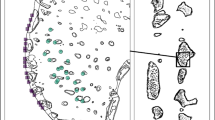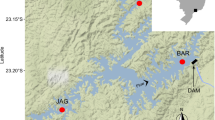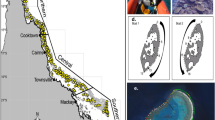Abstract
In marine organisms, pelagic larval dispersal often results in genetic panmixis among widely separated populations; however, local conditions may produce populations of marine organisms that differ in key life history traits. Here, we assess spatial differences in growth, body condition, survivorship and movement over a decade for lemon damselfish Pomacentrus moluccensis. Newly recruited fish were tagged on the southern (One Tree Island, 23°S), and northern Great Barrier Reef (Lizard Island, 15°S), 1200 km apart, and monitored for over a decade to provide direct data on growth and survivorship. New recruit physiological condition (lipid content) had a weak positive influence on early survival, but not on long-term persistence or growth, and the larval supply signal was lost after 2 years, suggesting post-settlement processes were key in long-term population persistence. Fish exhibited extreme site fidelity, with older/larger fish moving most (all less than 7 m). At Lizard Island, under 5% of individuals remained after 3 years, none after 4 years, while at One Tree Island 5% of individuals survived over 5 years, with 1% remaining after a decade, suggesting Lizard Island populations may require more frequent replenishment to persist. Among-site (within location) variation in mortality was high, and not related to density, suggesting local conditions such as wave exposure and predators were important. Surprisingly, mean growth at the two locations, which differ by around 2 °C on average in sea temperature, was practically identical, levelling off after 3 years, but with high variation among nearby sites within each location, which would affect size-based fecundity and time of first reproduction at these smaller spatial scales. Neither early post-settlement growth nor mortality were density-dependent, and early growth was not related to overall longevity. These small reef fishes are highly sedentary and some demographic parameters, but not others, differ at a range of scales, with post-settlement populations likely driven largely by mortality patterns at the larger spatial scale. Latitudinal and smaller-spatial scale differences in performance (growth, survival) of this species, leading to offsets in expected time to maturity an fecundity, are contrasted by evidence of stability of adult populations over two decades at One Tree Island, which suggests that resilience to environmental change/climate change and other externalities differ considerably across this species’ distribution.






Similar content being viewed by others
References
Armsworth PR (2002) Recruitment Limitation, Population Regulation, and Larval Connectivity in Reef Fish Metapopulations. Ecology 83:1092-1104
Beukers J (1996) The relative roles of recruitment and post-recruitment processes in the regulation of a coral reef damselfish population. PhD thesis. James Cook University, Australia, 128pp
Beukers J, Jones G (1998) Habitat complexity modifies the impact of piscivores on a coral reef fish population. Oecologia 11:, 50–59
Booth DJ (2002) Larval supply, condition and persistence of the coral reef fish, Pomacentrus moluccensis pp.463 – 468 In: Kasim Moosa, M.K., Soemodihardjo, S., Nontji, A., Soegiarto, A., Romimohtarto, Sukarno and Suharsono. (Editors) Proceedings of the Ninth International Coral Reef Symposium, Bali, Indonesia, October 23–27 2000. Published by the Ministry of Environment, the Indonesian Institute of Sciences and the International Society for Reef Studies.
Booth DJ (2014) Do otolith increments allow correct inferences about age and growth of coral reef fishes? Coral Reefs. 33: 255–258
Booth DJ (2016) Ability to home in small site-attached coral reef fishes. Journal of Fish Biology, 89(2), 1501-1506
Booth DJ, Beretta GA (2004) Influence of recruit condition on food competition and predation risk in a coral reef fish. Oecologia 140: 289-294
Booth DJ, Hixon MA (1999) "Food ration and condition affect early survival of the coral reef damselfish, Stegastes partitus." Oecologia 121(3): 364-368
Booth DJ, Kingsford MJ, Doherty PJ, Beretta GA (2000) Recruitment of Damselfishes in One Tree Island Lagoon: Persistent Interannual Spatial Patterns. Marine Ecology Progress Series, 202: 219-230
Brandl SJ, Goatley CHR, Bellwood DR, Tornabene L (2018) The hidden half: ecology and evolution of cryptobenthic fishes on coral reefs. Biol Reviews 93: 1846-1873
Brunton, B. J., & Booth, D. J. (2003). Density- and size-dependent mortality of a settling coral-reef damselfish (Pomacentrus moluccensis Bleeker). Oecologia, 137(3), 377-384
Dahlglen C, Eggleston DB (2000) Ecological processes underlying ontogenetic habitat shifts in a coral reef fish. Ecology 81:2227-2240
Doherty PJ, Fowler A (1994a) An empirical test of recruitment limitation in a coral reef fish. Science 263: 935-939
Doherty PJ, Fowler A (1994b) Demographic consequences of variable recruitment to coral reef fish populations: a congeneric comparison of two damselfishes. Bulletin of Marine Science 54: 297-313
Duarte CM, Alearaz M (1989) . To produce many small or few large eggs: a size-independent reproductive tactic of fish. Oecologia 80: 401-404
Elsdon TS, Wells BK, Campana SE, Gillanders BM, Jones CM, Limburg KE, Secor DH, Thorrold SR, Walther BD (2008) Otolith chemistry to describe movements and life-history parameters of fishes – hypotheses, assumptions, limitations and inferences. Oceanography and Marine Biology Annual Review. 46:297-330
Gaillard J-M, Festa-Bianchet M, Yoccoz NG, Loison A, Toigo Annu C (2000) Temporal variation in fitness components and population dynamics of large herbivores. Annual Review of Ecology and Systematics 31:367–93
Gust N, Choat J, Ackerman J (2002) Demographic plasticity in tropical reef fishes. Marine Biology 140: 1039–1051
Hixon A., Anderson TW, Buch KL, Johnson DW, McLeod R, Stallings C (2012) Density dependence and population regulation in marine fish: a large-scale, long-term field manipulation. Ecological Monographs 82: 467–489
Hoey AS, McCormick MI (2004) Selective predation for low body condition at the larval-juvenile transition of a coral reef fish. Oecologia 139: 23-29
Jone GP (1990) The importance of recruitment to the dynamics of a coral reef fish population. Ecology 71:1691-1698
Jones P. (1986) Food availability affects growth in a coral-reef fish. Oecologia 70: 136-139
Jones GP, Milicich MJ, Emslie MJ, Lunow C (1999) Self-recruitment in a coral reef fish population. Nature 4902:802-804
Josephson DC, Robinson JM, Widell BC, Kraft, C.E. 2008. Long-term retention and visibility of Visible Implant Elastomer tags in brook Trout. North American Journal of Fisheries Management 28:1758–1761
Kritzer JP, Sale, PF (2006) The metapopulation ecology of coral reef fishes In: Sale JPKF, Ed). Marine Metapopulations. Chapter 2. Burlington: Academic Press; pp. 31–67
Lee AM, Engen S, Sæther BE (2011) The influence of persistent individual differences and age at maturity on effective population size. Proceedings of Biological Science. 278:3303-12
Lewis AR (1997) Recruitment and post-recruit immigration affect the local population size of coral reef fishes Coral Reefs 16: 139-149
Mann R, Gallagher SM (1985) Physiological and biochemical energetics of larvae of Teredo navalis and Bankia gouldi. Journal of Experimental Marine Biology and Ecology 85: 211–228
Mapstone BD (1988) The determination of patterns in the abundance of Pomacentrus moluccensis Bleeker on the southern Great Barrier Reef. Unpublished PhD Thesis, University of Sydney, pp. 240
McCormlck M1, Molony BW (1995) Influence of water temperature during the larval stage, on size, age and body condition of a tropical reef fish at settlement Marine Ecology Progress Series 118:59–68
Meekan MG (1992) Limitations to the back-calculation of recruitment patterns from otoliths. Proceedings of the Seventh International Coral Reef Symposium, Guam, 1: 624-628
Mora C, Aburto-Oropeza O, Bocos A, Ayotte PM, Banks S, Bauman AG, . Zapata FA, plus 55 authors (2011) Global human footprint on the linkage between biodiversity and ecosystem functioning in reef fishes. PLOS Biology, 9: e10006.
Munch SB, Salinas S (2009) Latitudinal variation in lifespan within species is explained by the metabolic theory of ecology. Proceedings of the National Academy of Sciences of the United States of America. 106:13860-4
Sale PF, Ferrell DJ (1988) Early survival of juvenile coral reef fishes. Coral Reefs. 7: 117-124
Taylor BM, Choat JH, DeMartini EE, et al. (2019) Demographic plasticity facilitates ecological and economic resilience in a commercially important reef fish. Journal of Animal Ecology 2019;88:1888–1900
Tupper M, Boutilier RG (1997) Effects of habitat on settlement, growth, predation risk and survival of a temperate reef fish. Marine Ecology Progress Series. 151:225-236
Warner RR, Chesson PL (1985) Coexistence mediated by recruitment fluctuations: a field guide to the storage effect. American Naturalist. 125:769-787
Acknowledgements
We would like to acknowledge the staff at Lizard Island Research Station, and One Tree Island Research Station for their support, and Will Figueira, Marcus Gregson, Ralph Alquezar for field assistance. The study was done under Great Barrier Reef Marine Park Authority Permit G11/34452.1 and UTS Animal Care and Ethics 2008-016A.
Author information
Authors and Affiliations
Corresponding author
Ethics declarations
Conflict of interest
The corresponding author states that there is no conflict of interest.
Additional information
Publisher's Note
Springer Nature remains neutral with regard to jurisdictional claims in published maps and institutional affiliations.
Topic Editor Morgan S. Pratchett
Supplementary Information
Below is the link to the electronic supplementary material.
Rights and permissions
About this article
Cite this article
Booth, D.J., Beretta, G.A. Long-term demographics of a coral-reef fish: growth, survival and abundance at several spatial scales. Coral Reefs 40, 1257–1266 (2021). https://doi.org/10.1007/s00338-021-02134-6
Received:
Accepted:
Published:
Issue Date:
DOI: https://doi.org/10.1007/s00338-021-02134-6




